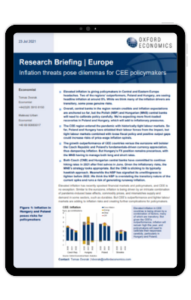Europe | Inflation threats pose dilemmas for CEE policymakers

Elevated inflation is giving policymakers in Central and Eastern Europe headaches. Two of the regions’ outperformers, Poland and Hungary, are seeing headline inflation at around 5%. While we think many of the inflation drivers are transitory, some pose genuine risks.
What you will learn:
- Central banks in the region remain credible and inflation expectations are anchored so far, but the Polish (NBP) and Hungarian (MNB) central banks will need to calibrate policy carefully. We’re expecting more front-loaded recoveries in Poland and Hungary, which will add to inflationary pressures.
- The growth outperformance of CEE countries versus the eurozone will bolster the Czech Republic and Poland’s fundamentals-driven currency appreciation, thus dampening inflation.
- Hungary’s FX position remains precarious, with the MNB having to manage both long and short rates.
Tags:
Related Services

Post
Closing our short SEK trade to capitalise on the Scandi FX sell-off
We expected a bout of SEK weakness following the Riksbank rate cut in the spring, but we think the recent sell-off is overdone, and we close our long EURSEK trade, opened in May.
Find Out More
Post
US Industrial and retail outperform over the next five years
In our recent real estate webinar, we showed that prices started to turn a corner. We predict industrial and retail will record the smallest value declines this year, and over the next five years, apartment and industrial are expected to record the strongest value growth on average. Both sectors are expected to reach their peak values of 2022 this decade.
Find Out More